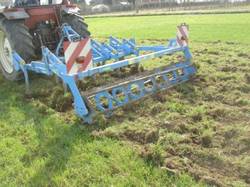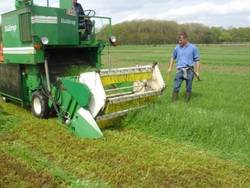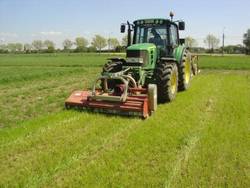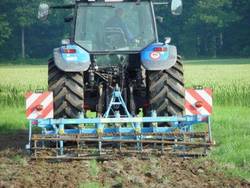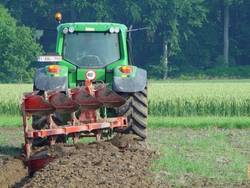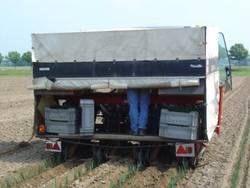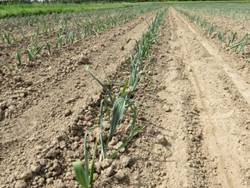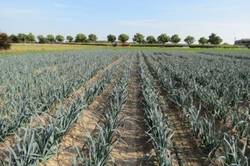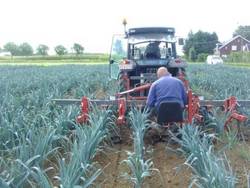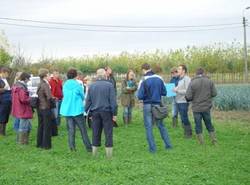Contact
Bert Van Gils
Onderzoeker raakvlakken landbouw en natuur
Instituut voor Landbouw- en Visserijonderzoek
Eenheid Plant - Teelt en omgeving
Burg. van Gansberghelaan 109
9820 Merelbeke
Tel +32 9 272 26 76
bert.vangils(at)ilvo.vlaanderen.be
www.ilvo.vlaanderen.be
Belgium: TILMAN-ORG field trials in 2012
In Belgium, TILMAN-ORG partner ILVO, the Institute for Agricultural and Fisheries Research, and the research and dissemination centre INAGRO conducted a field trial with leek in 2012. Bert van Gils from ILVO reports.
This field trial with leek (Antiope) followed a green manure crop of grass clover. (See also work package 5 of the TILMAN-ORG project: " Improved Nutrient Management in Reduced Tillage Systems by Use of Green Manures and Appropriate Off-Farm Inputs".
Experimental design
The grass clover was destroyed in three different ways:
- early destruction in March (gm1),
- late destruction in May after removal of the first cut (gm2), or
- late destruction after repeated mulching without removal of biomass (gm3).
Destruction was performed mechanically by non-inversion tillage with a cultivator (Actisol) and rotary harrow. This was repeated twice to destroy the grass clover sward. Apart from nutrients from this sward, no other manuring occurred on the field trial at ILVO in 2012.
An existing long-term experiment from Inagro was integrated into the project. The trial consists of two strips that received a non-inversion versus inversion tillage treatment since 2006. In 2012, timing of grass-clover sward destruction was added as an extra factor to this experiment, i.e. early destruction (gm1) and late destruction without removal of biomass (gm3). The whole parcel received cattle manure with straw bedding at a rate of 30 t/ha.
Soil preparation before planting in June consisted of inversion vs. non-inversion tillage. In both experiments and on all treatments the leek crop developed quite well. Mechanical weed control was performed regularly. Regrowth of grass from the previous green manure crop occurred, especially in non-inversion tillage treatments. After the diagnosis of leek moth (Acrolepiopsis assectella), the entire field was treated twice with XenTari® (Bacillus thuringiensis) in August.
On both experiments, soil sampling (0 to 10 cm, 10 to 30 cm and 30 to 60 cm) was performed four times, in March, June, August and October. All samples were analyzed for mineral nitrogen. Measurements of CO2 emissions from the soil were performed only on the ILVO field trial. In October, both field trials were harvested after crop sampling and yield assessment.
Effect of the different treatments with the grass-clover green manure crop
Differences in timing of destruction of the grass-clover green manure crop, with or without removal of the first cut, led to a different nitrogen supply for the following leek crop. In general, early destruction (gm1) led to a higher mineral nitrogen level in the subsoil. In the Inagro field trial there were no differences in this aspect between early and later sward destruction in the second half of the growing season. But in general, the soil mineral nitrogen content of this trial was remarkably higher than that of the ILVO trial.
Crop yield in the ILVO trial was consistent with the N amount that was applied with the grass-clover, rather than with the soil mineral nitrogen level. Effects of differences in grass-clover sward destruction in the Inagro trial were less pronounced. It was also remarkable that the higher soil mineral nitrogen content on the Inagro trial as compared to the ILVO trial did not automatically result in a higher crop yield. Soil nitrogen availability is far from the only parameter that affects crop yield, as was proved by another observation on the ILVO trial: gm3 plots, which showed the highest yield, did not have the highest nitrogen availability during the growing season. Soil conditions as well as weather conditions probably have a great impact on nitrogen uptake and hence crop yield.
Effects of soil management
A second research topic for these field trials is the effect of non-inversion tillage vs. inversion tillage by ploughing.Looking at the entire soil profile (0 to 60 cm), the ILVO field trial did not show significant differences in nitrogen availability between both tillage types. But in the top soil layer (0 to 10 cm), plant available nitrogen content was relatively higher for the August samples of non-inversion tillage plots. On the Inagro trial, during the entire growing season the non-inversion strip showed slightly higher nitrogen availability. On both trials, no significant effects were observed for crop yield between inversion and non-inversion tillage.
 This website was archived on January 11, 2020 and is no longer updated.
This website was archived on January 11, 2020 and is no longer updated.
